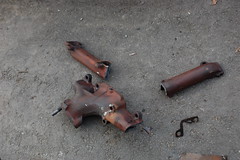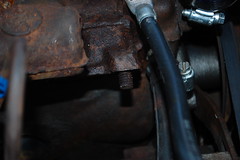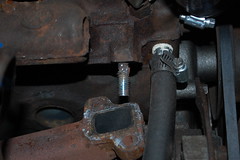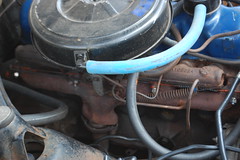 As I have said before, the exhaust manifold on the “new” engine was cracked, so I needed to pull it and swap the good manifold from the old engine. Ford sixes are notorious both for cracked manifolds and for the bolts rust-welding themselves to the head. A fun combination. So in the days leading up I sprayed the bolts with PB Blaster and Freeze Off. Once I started in I used a bolt extractor to get a grip on the badly rusted heads.
As I have said before, the exhaust manifold on the “new” engine was cracked, so I needed to pull it and swap the good manifold from the old engine. Ford sixes are notorious both for cracked manifolds and for the bolts rust-welding themselves to the head. A fun combination. So in the days leading up I sprayed the bolts with PB Blaster and Freeze Off. Once I started in I used a bolt extractor to get a grip on the badly rusted heads.

End result was six bolts actually coming loose, four snapped off bolt heads and one bolt who’s head stripped badly without shifting. I spent the next while trying to shift the stubborn bolt, I tried the bolt extractor, vise-grips, welding a nut onto the head and probably a half-dozen other things without the slightest sign of movement.
 I finally gave up and cut the head off with an angle grinder, and pried the manifold off in pieces. The places it snapped in the pic are not where the cracks were, but just the result of overly enthusiastic prying. Fortunately I didn’t need this piece anymore. Frustratingly, the bolt that had given me so much hassle and wasted so much time, once the manifold was off it came out in moments with a pair of vise-grips.
I finally gave up and cut the head off with an angle grinder, and pried the manifold off in pieces. The places it snapped in the pic are not where the cracks were, but just the result of overly enthusiastic prying. Fortunately I didn’t need this piece anymore. Frustratingly, the bolt that had given me so much hassle and wasted so much time, once the manifold was off it came out in moments with a pair of vise-grips.
 Once the manifold was off I still had the problem of the four bolts that had snapped off. I was lucky in that they hadn’t snapped off flush, but I still couldn’t budget them. Vise grips would just chew them up, and attempts to heat or freeze them didn’t do a thing. I even tried welding a nut to them and putting a wrench on it. All I did was snap the nut back off.
Once the manifold was off I still had the problem of the four bolts that had snapped off. I was lucky in that they hadn’t snapped off flush, but I still couldn’t budget them. Vise grips would just chew them up, and attempts to heat or freeze them didn’t do a thing. I even tried welding a nut to them and putting a wrench on it. All I did was snap the nut back off.
 Finally I gave in and decided that if the bolt wanted to be a permanent part of the head, I would take advantage of that instead of fighting it. So I cut the bolt back about half way with an angle grinder to get a flat surface. Next I cut the heads off some short bolts and chamfered the ends to give my weld someplace to bite.
Finally I gave in and decided that if the bolt wanted to be a permanent part of the head, I would take advantage of that instead of fighting it. So I cut the bolt back about half way with an angle grinder to get a flat surface. Next I cut the heads off some short bolts and chamfered the ends to give my weld someplace to bite.
 Then one by one I welded the new bolts to the old once, effectively creating a stud I could put a washer & nut on. Because I was working down in the engine bay I had no good way to get the pieces aligned perfectly straight. So after welding each one I had to grind the welds down and test fit the manifold. I was lucky in that they all ended up straight enough to allow the manifold to slide on and off easily.
Then one by one I welded the new bolts to the old once, effectively creating a stud I could put a washer & nut on. Because I was working down in the engine bay I had no good way to get the pieces aligned perfectly straight. So after welding each one I had to grind the welds down and test fit the manifold. I was lucky in that they all ended up straight enough to allow the manifold to slide on and off easily.
 Add some stainless steel hardware & a new manifold gasket and the project was done.
Add some stainless steel hardware & a new manifold gasket and the project was done.

One technique I use to remove stuck studs or bolts THAT I CAN REACH is to soak them with Blaster PB, and let them sit a while….4-6 hours, occasionally giving them another dose.
Then I grip the stud with large vise grips, REALLY tightly! and use a torch (propane works OK for this) to warm up the IRON the bolt is stuck into. This will take a while to heat the metal up well.
Once the area is hot, I spray the bolt and it’s base where it screws into the block (but not the block!) with more Blaster, be aware it may flare up and burn, just blow it out.
NOW carefully using a little leverage, work the vise-grips a little, VERY little, back and forth, only putting a little pressure on the bolt maybe on 1/8th of an inch in each direction…just work it back-and-forth.
Here’s what happens: the Blaster will cool the bolt a bit, making it marginally smaller in the bolt hole. The vise grips also act as a heat sink, and if it gets too hot just change it out for another, or cool it with a tub of water and re-clamp it on.
The pressure back-and-forth will break the bonds of the rust, allowing increasingly larger movements of the bolt in the threaded hole. Add Blaster as needed.
Repeat the heating and Blaster treatments, and 95+% of the time I get the bolts out.
I learned this while working in an exhaust shop, removing frozen studs from exhaust manifolds.
Using this technique I have brought back from the dead, tools and materials that were solid blocks of rust.
The trick again, is to work the bolt EVER SO SLIGHTLY back and forth. This will actually twist the bolt slightly along it’s length (kinda the way torque rods or springs work), allowing the bolt to twist ever so slightly, breaking the rust bond a few molecules at a time.
Simply out-stubborn the bolts. You Will Win.
And by putting pressure on the wrench to move it 1/8th of an inch, I mean moving the HANDLE of the vise-grips 1/8th of an inch, NOT the bolt.
You do not, of course, want to torque and snap the bolt…
I presume you will use Never-Seez during re-assembly.
I’ll keep that trick in mind.